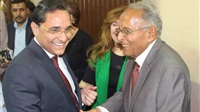North Korea’s Kim urges quick recovery from typhoon damage

North Korean leader Kim Jong Un called for urgent
efforts to rebuild thousands of homes and other structures destroyed by a
typhoon that slammed the country’s eastern region last week, state media said
Wednesday.
Kim during the Workers’ Party meeting Tuesday also
said the damage from Typhoon Maysak has forced the country to reconsider
unspecified year-end projects, the North’s official Korean Central News Agency
said.
The storm has inflicted further pain on an economy
ravaged by decades of policy failures, U.S.-led sanctions over Kim’s nuclear
weapons program, border closures amid the coronavirus pandemic and unusually
heavy summer flooding that likely worsened the country’s chronic food
shortages.
Some experts say Kim by staging high-level political
conferences and visits to disaster areas in recent weeks is likely trying to
project an image of a compassionate leader looking after his people as he seeks
to bolster internal unity in face of economic setbacks and external pressure.
KCNA said Maysak left “severe damage” in the eastern
town of Komdok, destroying or flooding more than 2,000 homes and dozens of
public buildings and paralyzing transport systems. More than 60 kilometers (37
miles) of roads in the region were “washed away,” while 59 bridges collapsed.
Several miles of railroads were damaged in mining areas, the report said.
During Tuesday’s meeting, Kim described the recovery
efforts at Komdok a national priority to revive “important arteries of the
national economy,” and ordered that the rebuilding of homes, roads and railways
be completed by Oct. 10, when the ruling party celebrates the 75th anniversary
of its founding.
During another political conference last month, Kim
displayed unusual candor by acknowledging that his plans to improve the
country’s dismal economy aren’t succeeding. During that meeting, the ruling
party scheduled a rare congress in January to set development goals for the
next five years.
The high-profile government meetings and mobilizing
of the military and Pyongyang elites are examples of Kim’s responsiveness but
the damage is testing state capacity and resources, said Leif-Eric Easley, a
professor at Ewha University in Seoul.
“The political risk to Kim of failing to deliver
promised reconstruction may be limited, but an accumulation of economic
failures will strain his regime,” Easley said.
KCNA said an unspecified number of party members
left Pyongyang on trains Tuesday to help the recovery efforts in typhoon-hit
areas. Trucks carrying construction tools and other supplies were also headed
to such sites, the agency said.
Kim had visited typhoon-stricken areas in the
country’s northeast over the weekend.







